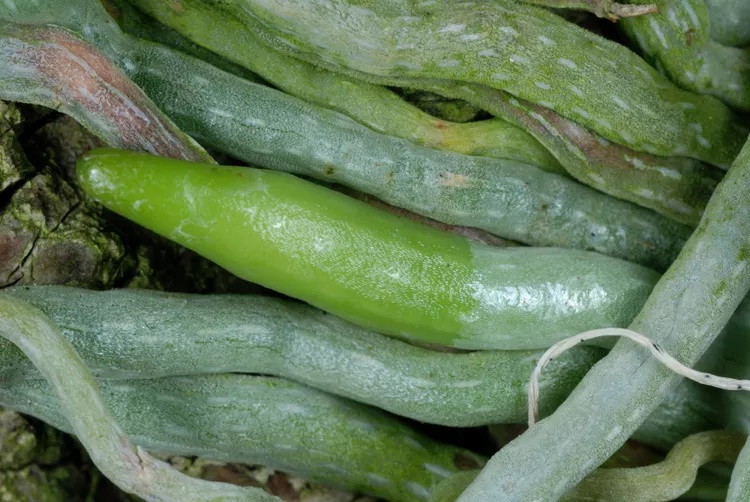
11 Enchanting Quirks of the Rare Ghost Orchid
4. Its roots act like leaves
roots of a ghost orchid
The green roots of a ghost orchid perform most of its photosynthesis and respiration.
Doug Goldman / USDA-NRCS PLANTS Database
The ghost orchid may not have leaves to speak of, but that doesn't mean it has given up on photosynthesis. Although its roots already have their hands full—they anchor the orchid onto its tree, while also taking in water and nutrients—they fill this role, too.
The roots contain the chlorophyll needed for photosynthesis, rendering leaves unnecessary. The roots also feature small white marks known as pneumatodes, which perform the gas exchange needed for respiration and photosynthesis.
When the orchid isn't in bloom, the mass of roots looks like "unremarkable bits of green linguine," as National Geographic described them.
5. Its flowers look like they're floating in the forest
ghost orchid, Dendrophylax lindenii, at Florida Panther NWR
An endangered ghost orchid blooms at the Florida Panther National Wildlife Refuge.
Josh O'Connor / U.S. Fish and Wildlife Service
The greenish roots blend in with the bark of trees where ghost orchids grow, making them well-camouflaged when they aren't blooming, especially in the dimly lit understory.
During the brief window when they do bloom, the flower grows on a thin spike extending outward from the roots. The roots act like a puppeteer dressed to match the background, dangling the flower as if it's floating freely in the forest.
Although ghost orchid is undoubtedly its coolest name, the plant is also known as "palm polly" or the "white frog orchid," a reference to the pair of long, lateral tendrils from its lower petal that vaguely resemble the hind legs of a frog.
6. It smells kind of like apples, especially in the morning
ghost orchid, Dendrophylax lindenii
Doug Goldman / USDA-NRCS PLANTS Database
At an undisclosed location in South Florida, about 13 ghost orchids abruptly bloomed in the summer of 2009, giving scientists a unique opportunity to study the species in the wild. That included a team of researchers who investigated the orchid's "floral headspace," using gas chromatography-mass spectrometry (GC-MS) to identify volatile compounds in the flower's scent.2
They identified several organic chemicals known as terpenoids, the most abundant of which was (E,E)-α-farnesene, a compound found in the natural coating of apples, pears, and other fruits.
From about 5 centimeters (2 inches) away, "the floral scent of D. lindenii was readily detectable to the authors," they reported in the European Journal of Environmental Sciences, "and seemed to intensify at sunset." The fragrance was most potent in the early morning, they added, between 1 and 6 a.m. local time. "The scent can best be described as sweet-smelling and somewhat fruity," they wrote.2
roots of a ghost orchid
The green roots of a ghost orchid perform most of its photosynthesis and respiration.
Doug Goldman / USDA-NRCS PLANTS Database
The ghost orchid may not have leaves to speak of, but that doesn't mean it has given up on photosynthesis. Although its roots already have their hands full—they anchor the orchid onto its tree, while also taking in water and nutrients—they fill this role, too.
The roots contain the chlorophyll needed for photosynthesis, rendering leaves unnecessary. The roots also feature small white marks known as pneumatodes, which perform the gas exchange needed for respiration and photosynthesis.
When the orchid isn't in bloom, the mass of roots looks like "unremarkable bits of green linguine," as National Geographic described them.
5. Its flowers look like they're floating in the forest
ghost orchid, Dendrophylax lindenii, at Florida Panther NWR
An endangered ghost orchid blooms at the Florida Panther National Wildlife Refuge.
Josh O'Connor / U.S. Fish and Wildlife Service
The greenish roots blend in with the bark of trees where ghost orchids grow, making them well-camouflaged when they aren't blooming, especially in the dimly lit understory.
During the brief window when they do bloom, the flower grows on a thin spike extending outward from the roots. The roots act like a puppeteer dressed to match the background, dangling the flower as if it's floating freely in the forest.
Although ghost orchid is undoubtedly its coolest name, the plant is also known as "palm polly" or the "white frog orchid," a reference to the pair of long, lateral tendrils from its lower petal that vaguely resemble the hind legs of a frog.
6. It smells kind of like apples, especially in the morning
ghost orchid, Dendrophylax lindenii
Doug Goldman / USDA-NRCS PLANTS Database
At an undisclosed location in South Florida, about 13 ghost orchids abruptly bloomed in the summer of 2009, giving scientists a unique opportunity to study the species in the wild. That included a team of researchers who investigated the orchid's "floral headspace," using gas chromatography-mass spectrometry (GC-MS) to identify volatile compounds in the flower's scent.2
They identified several organic chemicals known as terpenoids, the most abundant of which was (E,E)-α-farnesene, a compound found in the natural coating of apples, pears, and other fruits.
From about 5 centimeters (2 inches) away, "the floral scent of D. lindenii was readily detectable to the authors," they reported in the European Journal of Environmental Sciences, "and seemed to intensify at sunset." The fragrance was most potent in the early morning, they added, between 1 and 6 a.m. local time. "The scent can best be described as sweet-smelling and somewhat fruity," they wrote.2
Advertisements
06 September 2023
Advertisements



